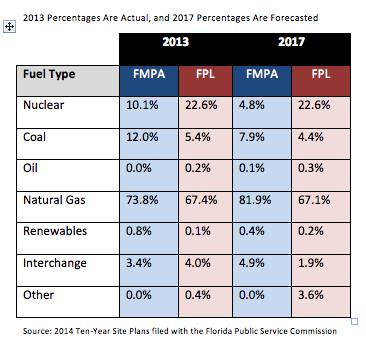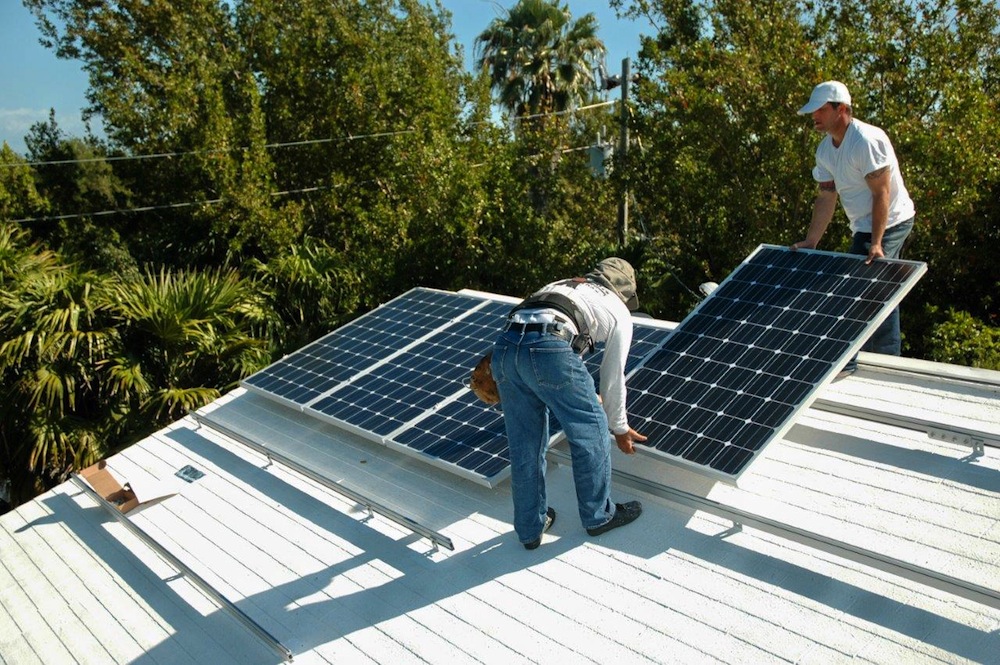The Dumbshine State
A rally last week in Tallahassee was staged to encourage solar energy development in Florida. Fortunately it became political because otherwise the mainstream media might not have covered it. Organizers used the event to accuse Gov. Rick Scott of blocking solar energy initiatives in the state at the behest of the big power companies.
Because Scott’s election-year rival, former Gov. Charlie Crist, attended the rally, the media paid some attention.
What should have made bigger news is how the state has placed its legislative thumb firmly on the development of renewable power. Florida has the third-largest potential for rooftop solar generation in the nation but ranks 18th in solar installations.
KEYS, which delivers power west of the Seven Mile Bridge, illustrates what is typical for the rest of the state. Look at information provided by KEYS spokesperson Lynne Tejeda about the sources of the utilities power.
Energy Sources by Fuel Type
 You’ll quickly see that renewables provide .8 percent of the current energy sent down the lines to Key West and that number will drop – drop – to .4 percent in 2017. Plunge to an incredibly low number. Of course Florida Power and Light’s renewables will double…from .1 percent to .2 percent.Source: 2014 Ten-Year Site Plans filed with the Florida Public Service Commission
You’ll quickly see that renewables provide .8 percent of the current energy sent down the lines to Key West and that number will drop – drop – to .4 percent in 2017. Plunge to an incredibly low number. Of course Florida Power and Light’s renewables will double…from .1 percent to .2 percent.Source: 2014 Ten-Year Site Plans filed with the Florida Public Service Commission
According to Florida Keys Electric Cooperative Member Service Representative TJ Patterson, the co-op negotiated a long-term contract with FPL for roughly 75percent natural gas, 22 percent nuclear and the other three percent is from solar. While gas is still a fossil fuel, it’s much cleaner than coal and oil.
According to The Miami Herald’s story about the solar rally,
“In Tallahassee, it’s pay to play right now – the ones that are controlling the money are controlling the power,’’ said Stephen A. Smith, director of the Southern Alliance for Clean Energy, a solar industry-backed group which advocates for the development of alternatives to fossil fuels. The group funded an Integrity Florida report that found that the state’s four top electric companies have spent $18 million between 2004-2012 on state and legislative campaigns.
In the last year, the utility companies have given the governor’s campaign $2.5 million this election cycle,” Smith said. “They get what they want.”
And what they want is to keep solar generation of power – either by them or by individuals – at an incredibly low number.
Here are some compelling statistics.
- Regionally, Florida installed less solar power over the past three years than Georgia installed in 2013 alone. Georgia.
- Florida has less than a quarter the amount of photovoltaic panels (PV) installed compared to North Carolina, despite having much more sun and nearly twice the population size.
- The U.S. (nationally) installed over 40 percent more solar PV in 2013 compared to 2012, yet Florida’s installation rate has remained flat (even decreasing) since 2009.
- Florida installed less solar in 2013 than 2010, despite the average price of PV systems declining by more than 50% over the same time period.
- Florida’s solar electric market provides less than 0.2% of Florida’s annual net generation.
All of this is no accident. It’s what the utilities want. Controlling 99.8 percent of power generation is not enough for them.
Grey, northern Germany does far better. The country’s PV installations feed 22 gigawatts of electricity into the grid, providing nearly half of the country’s energy needs. The country has reshaped its policy away from nuclear power and toward renewable sources like solar, wind and biomass.
Germany’s solar days are measured in hours, not days. In a recent year, Berlin received 1625 hours of sun or partial sun. That works out to 67 days and change. During a recent year in the Keys, Key West got 259 days of sun or partial sun. All of South Florida has similar numbers.
Does any of this matter? It matters only to anyone who still thinks the freight train of global warming can even be slowed. The consequences of that warming will have a particularly harsh effect on low-lying Florida with its hundreds of miles of seacoast. Even the Department of Economic Opportunity has begun to develop plans for what it’s calling Adaptation Action Areas. These involve pilot projects for adapting to sea-level rise. Monroe County and other low lying areas will need to raise roads, build levees, raise buildings, improve wastewater systems, and a lot more. Right now there is neither the will nor the money to do either.
According to the latest Intergovernmental Panel on Climate Change (IPCC) report, to prevent a catastrophic increase of four degrees Centigrade, “the share of zero and low carbon energy sources like solar, wind, nuclear, and unproven technologies like fossil fuel with Carbon Capture and Storage (CCS) [which no one has done successfully] must at least triple by 2050, and greenhouse gas emissions will have to fall 40- 70 percent, compared to 2010 levels.”
The report continues,
“It’s basically pretty simple. Fossil fuels are high carbon sources of electricity while other generation sources are low carbon. Coal is the most carbon intensive, followed by oil and then natural gas. Solar PV and geothermal are slightly more carbon intensive than other non-fossil sources, but still very low carbon compared to any fossil fuel.”
On a national level, in an even stranger turn of events, other utilities are trying to prevent homeowners from installing solar panels on their roofs. Investor-owned utilities (IOUs), led by their trade group the Edison Electric Institute, last fall launched a state-by-state campaign claiming that net metering creates a threat to their traditional regulated-monopoly business model. Net metering means that people with solar panels can sell excess energy back to the utility at a set rate.
IOUs want to slash net-metering rates, or impose high fixed-rate connection fees or surcharges, or eliminate net metering entirely. Where they’re successful, they will reduce the value of solar to homeowners and sharply cut the profits of third-party solar providers (often called leasing companies) like SolarCity, Sunrun, Sungevity and Verengo.
That’s no problem in Florida because Florida has no renewable portfolio standard; does not allow customer power purchase agreements; and has onerous taxes on leased solar systems. That’s why the big leasing companies don’t offer rooftop solar panel leasing in a state that gets the third most solar energy in the entire country.
It’s also the reason why there are so few solar PV installations in the Keys. There are 34 complete ones in the area served by the Florida Keys Electric Cooperative with two more being installed and two more applications. KEYS has 31 interconnected customers but this includes their own three projects: Solar at Stock Island; Wind at Cudjoe (which isn’t solar) and Solar with NOAA at the Eco Discovery building.
Since there are approximately 30,000 households in the Keys, the percentage of total solar installations is two percent. Not exactly a real threat to any utility.
Solar PV installations are not inexpensive making leasing so attractive. But, crushed under the Florida legislature’s very large thumb, it’s not a viable option here.
Clearly the desire for greater current income by the utilities trumps any desire to head off global warming and the ensuing sea-level rise. On a national level concerns about cost and economic growth are also considered much more important than doing anything significant about the climate. Here that means that economics is more important than the reef, more important than commercial fishing, and much more important than the loss of value of homes when the seas rise. And none of that makes much sense.

mr welber
what companies in the keys do solar pv installations? i have found no reliable source yet as i would like to go solar for my home. thanks in advance for your responce.
Contact Solaria in Marathon. They designed my system and can help you. 289-7980. Ask to speak to Steve.
Key West discourages solar panels, not consistent with historical architecture. Keys Energy Service’s motto, “Growing Greener Every Day” seems to mean making more money every day. Maybe Craig Cates’ Facebook re-election says “Keep Key West clean and green” A way to do that is to require all new construction to have maximum solar panels on the roof. There isn’t any land to install much in the way of solar on the ground. However, a fellow who called himself “Solar Richard”, from Oregon, as I recall, came to Key West and we had several conversations about Key West going solar. Solar Richard sort of reminded me of what I had read about Nikolas Telsa. Solar Richard’s idea was to build a big solar farm in a nearby bay. He said there were solar panels then being made, which were saltwater tolerant. Someone else, I can’t recall who, suggested putting solar panels all over Mt. Trashmore. It’s got so much toxic material buried in it that it can’t be used for much else. From what I’ve see and heard of Keys Energy Services, they indeed have little, if any, interest in their part of the Florida Keys, which lies below Seven Mile Bridge, going solar. John Hammerstrom in Tavernier also is a good person to speak with about solar. He had one of the first solar homes built, perhaps the first one? He told me that his home is designed to receive electricity from the electric company up there when his solar system is not generating electricity, and when his system is generating electricity, that what his home uses, and any extra electricity his home generates goes back to the electric company. He said in a good year, he might sell $100 worth of electricity to the electric company. So, he is not really making money, as some say is possible, having a solar home designed in that way,but he is using a lot of solar-generated electricity and a lot less conventional-generated electricity, and I imagine he is saving a good bit of money in utility bills. I don’t recall what he said was the payback time, when his solar system was paid for by his power bill savings. I think John, too, has a relationship with Solaria in Marathon. I think I recall the owner of Solaria telling me he also has an electric compost toilet, which the County approved, which was another way he went more green and perhaps saved money on his sewer and water bill.
Some asked me today if solar panels on roofs and white roofs violate Key West City Code, and I replied “seems so”. Head where the sun never shines best describe’s Key West’s solar energy policy.
According to the LA Times: The Koch brothers and large utilities have allied to reverse state policies that favor renewable energy. Environmentalists are pushing back, but the fight is spreading and intensifying.
http://www.latimes.com/nation/la-na-solar-kochs-20140420,0,7412286.story#ixzz2zcfWabrg